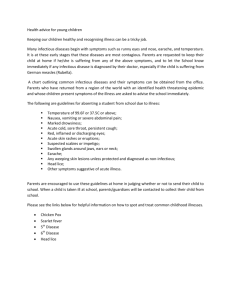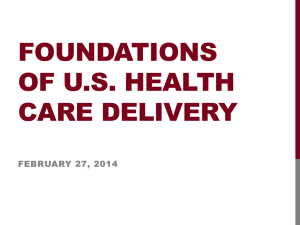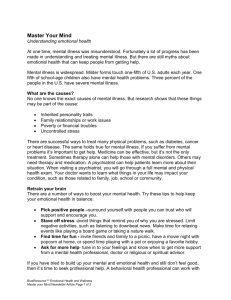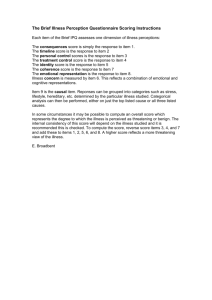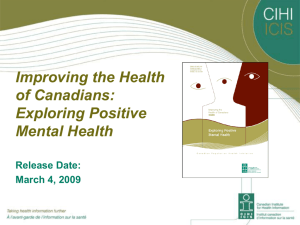HE:319 Chapter 2
advertisement
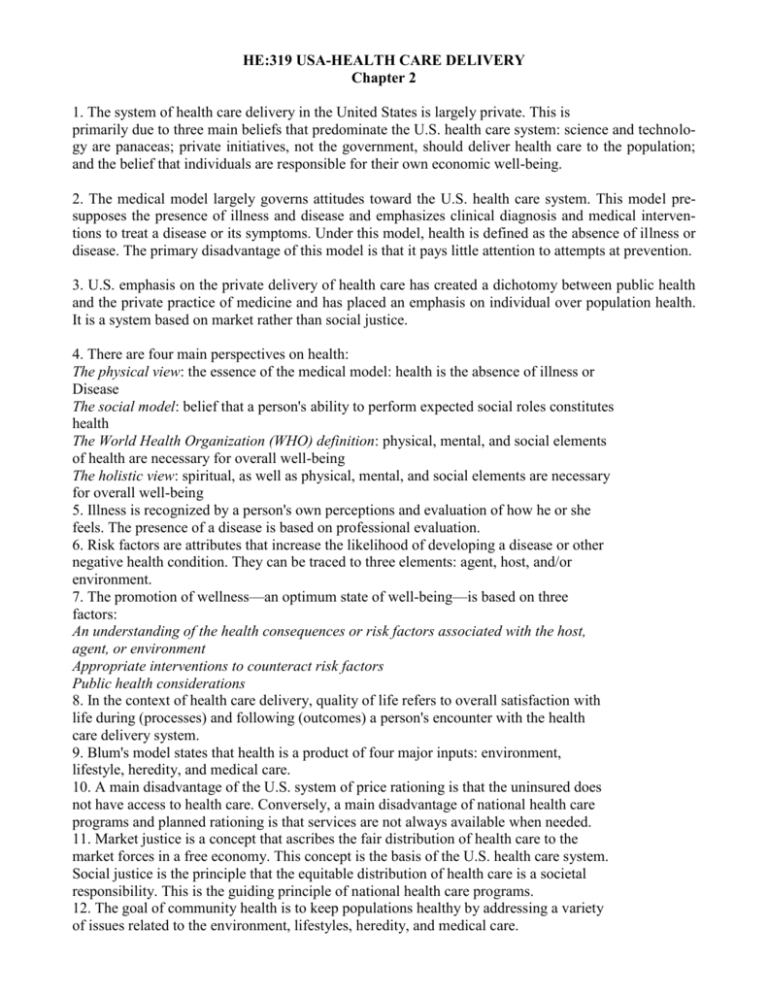
HE:319 USA-HEALTH CARE DELIVERY Chapter 2 1. The system of health care delivery in the United States is largely private. This is primarily due to three main beliefs that predominate the U.S. health care system: science and technology are panaceas; private initiatives, not the government, should deliver health care to the population; and the belief that individuals are responsible for their own economic well-being. 2. The medical model largely governs attitudes toward the U.S. health care system. This model presupposes the presence of illness and disease and emphasizes clinical diagnosis and medical interventions to treat a disease or its symptoms. Under this model, health is defined as the absence of illness or disease. The primary disadvantage of this model is that it pays little attention to attempts at prevention. 3. U.S. emphasis on the private delivery of health care has created a dichotomy between public health and the private practice of medicine and has placed an emphasis on individual over population health. It is a system based on market rather than social justice. 4. There are four main perspectives on health: The physical view: the essence of the medical model: health is the absence of illness or Disease The social model: belief that a person's ability to perform expected social roles constitutes health The World Health Organization (WHO) definition: physical, mental, and social elements of health are necessary for overall well-being The holistic view: spiritual, as well as physical, mental, and social elements are necessary for overall well-being 5. Illness is recognized by a person's own perceptions and evaluation of how he or she feels. The presence of a disease is based on professional evaluation. 6. Risk factors are attributes that increase the likelihood of developing a disease or other negative health condition. They can be traced to three elements: agent, host, and/or environment. 7. The promotion of wellness—an optimum state of well-being—is based on three factors: An understanding of the health consequences or risk factors associated with the host, agent, or environment Appropriate interventions to counteract risk factors Public health considerations 8. In the context of health care delivery, quality of life refers to overall satisfaction with life during (processes) and following (outcomes) a person's encounter with the health care delivery system. 9. Blum's model states that health is a product of four major inputs: environment, lifestyle, heredity, and medical care. 10. A main disadvantage of the U.S. system of price rationing is that the uninsured does not have access to health care. Conversely, a main disadvantage of national health care programs and planned rationing is that services are not always available when needed. 11. Market justice is a concept that ascribes the fair distribution of health care to the market forces in a free economy. This concept is the basis of the U.S. health care system. Social justice is the principle that the equitable distribution of health care is a societal responsibility. This is the guiding principle of national health care programs. 12. The goal of community health is to keep populations healthy by addressing a variety of issues related to the environment, lifestyles, heredity, and medical care. 13. Quantitative measurements are often applied to health, health status, and the utilization of health care. Factors indicating health status include self-perceived health status, longevity, morbidity, disability, and mortality. . TERMINOLOGY Activities of daily living (ADLs) measure a person’s ability to function independently, especially in reference to one’s ability to perform six basic activities: eating, bathing, dressing, toileting, maintaining continence, and getting into or out of a bed or chair. An acute condition is relatively severe, of short duration, and often treatable. An agent, one of the factors of the epidemiology triangle, must be present in order for an infectious disease to occur. In other words, an infectious disease cannot occur without an agent. The term cases, refers to individuals who acquire a certain disease or condition. A chronic condition is less severe than an acute condition but of long and continuous duration. The patient may not fully recover. The presence of disease is based on professional evaluation as opposed to self-evaluation. An epidemic occurs when a large number of people get a specific disease from a common source. Extended health assessment is a very broad perspective of a population’s health. It includes an elaborate history and physical of individuals, and it amasses a wide variety of information such as how often people exercise, whether children are exposed to lead, the extent of seat-belt use, family incomes, violent crimes, and sources of water supply. Fertility is the capacity of a population to reproduce. Health risk appraisal refers to the evaluation of risk factors and their health consequences for individuals. Health risk appraisal is an important aspect of health promotion and disease prevention because it can be instrumental in developing avenues for motivating individuals to alter their behaviors to more healthful patterns. Holistic health emphasizes the well-being of every aspect of what makes a person whole and complete. Holistic medicine seeks to treat the individual as a whole person. A host, one of the factors of the epidemiology triangle, is an organism, generally a human, who receives the agent. The host is the organism that becomes sick. Illness is recognized by means of a person’s own perceptions and evaluation of how he or she feels. For example, an individual may feel pain, discomfort, weakness, depression, or anxiety, but a disease may or may not be present. Immigration means migration to a defined geographic area. Incidence counts the number of new cases occurring in the population at risk within a certain time period, such as a month or a year. Instrumental activities of daily living (IADLs) are used in reference to a person’s ability to perform activities that are necessary for living independently in the community, such as preparing meals, shopping for routine items, managing money, and housekeeping. Life expectancy is the prediction of how long a person will live. The medical model of health care delivery presupposes the existence of sickness. In other words, health care is delivered only when a person is sick. The model emphasizes diagnosis and treatment of disease as opposed to health promotion and disease prevention. Morbidity means disease or disability. Mortality is the term used in the measurement of death rates. Natality refers to the birth rate. The population at risk includes all the people in the same community or population group who are susceptible to acquiring a disease or a negative health condition. Prevalence measures the total number of cases (of death, disability, or disease) at a specific point in time in the population at risk. Primary prevention refers to actions designed to reduce the odds that a disease will subsequently develop. Its objective is to restrain the development of a disease or negative health condition before it occurs. Smoking cessation, prenatal care, hand washing, and refrigeration of foods are examples of primary prevention. Public health deals with broad societal concerns about ensuring conditions that promote optimum health for society as a whole by influencing the social, economic, political, and medical care factors that affect health and illness. 2 The objective of public health is to prevent disease, prolong life, and promote health through organized community effort. Quality of life refers to overall satisfaction with life during and following a person’s encounter with the health delivery system. Some of the life domains germane to quality of life are comfort factors, security, degree of independence, decision-making autonomy, and attention to personal preferences. Risk factors are attributes that increase the likelihood of developing a particular disease or negative health condition at some time in the future. Risk factors can be traced to the agent, the host, and/or the environment. Secondary prevention refers to early diagnosis and treatment of disease. Health screening plays a key role in secondary prevention. The objective is to block the progression of disease. Social contacts are evaluated in terms of the number of social contacts or social activities a person engages in within a specified period of time. Examples are visits with friends and relatives and attendance at social events, such as conferences, picnics, or other outings. Social justice regards health care as a social good that should be collectively financed through general taxes, and made available to all citizens regardless of the individual’s ability to pay. Social resources refer to social contacts that can be relied upon for support, such as family, relatives, friends, neighbors, and members of a religious congregation. They are indicative of adequacy of social relationships. A subacute condition is between acute and chronic, but with some acute features. The wellness model views health as a positive concept. The model emphasizes efforts and programs geared toward prevention of disease and maintenance of an optimum state of well-being.


